There can be your advertisement
300x150
Secrets of the Ryabushinsky Manor: Schextel's Modern and Hidden Old-Believer Praying Room
One of the most striking and mysterious architectural treasures of Moscow
Located in the very center of Moscow, on Malaya Nikitskaya Street, stands a building that captivates the imagination even among connoisseurs of architecture. The Ryabushinsky Manor is a true masterpiece of Moscow modernism and at the same time a house with secrets, where aesthetics intertwines with faith, and luxury conceals hidden rooms. Created by the genius architect Fedor Schextel at the beginning of the XX century, this manor preserves wonderful stories of its owners and inhabitants.
Main points from the article:
The manor was built in 1900-1903 by Fedor Schextel for millionaire Old-Believer Stepan Ryabushinsky;
A hidden Old-Believer praying room was secretly placed in the house, skillfully disguised from outsiders;
The house represents an outstanding example of the modern style with unique interiors;
From 1931 to 1936, the writer Maxim Gorky lived here after returning from Italy;
Today, the manor houses Maxim Gorky's museum apartment, where original Schextel interiors are preserved.
The Ryabushinskys: Old-Believers and Millionaires
The history of the manor is inseparably linked with the Ryabushinsky family — one of the most powerful merchant dynasties of pre-revolutionary Russia. The founder of the dynasty, Mikhail Ryabushinsky, started as a simple peasant, but thanks to entrepreneurial ambition, he created a textile empire that his sons expanded by adding banks, insurance companies, and industrial enterprises.
Stepan Pavlovich Ryabushinsky, the manor's patron, was one of the most successful members of the dynasty. Unlike his brothers, more known in business and political circles, Stepan was a collector who was passionate about art and especially ancient Russian icon painting.
A key feature of the Ryabushinsky family was their affiliation with Old Belief — a religious movement that refused to accept the church reforms of the 17th century. Despite long periods of persecution, by the beginning of the XX century many of them, including the Ryabushinskys, had become influential entrepreneurs and patrons.
Old-Believers formed a kind of closed club of Russian merchants. They supported each other in business, gave interest-free loans to fellow believers, but tried not to publicize their faith, especially before the edict on religious tolerance in 1905.
Fedor Schextel: Genius of Moscow Modernism
For the construction of his manor, Stepan Ryabushinsky chose Fedor Osipovich Schextel — an architect who was already considered one of the leading masters of the new architectural style, modernism. By that time, Schextel had already built the famous manor of Zinaida Morozova on Spiridonovka and the Derzhinskaya house on Kropotkinskaya.
Schextel was not just an architect — he was a true artist who thought through everything down to the smallest detail: from the overall concept of the building to door handles and window frames. While working on the Ryabushinsky manor, he created a complete work of art where architecture, interior design, and décor formed a single harmonious whole.
Schextel often said that an architect should be simultaneously a painter, engineer, and psychologist. He studied the character of the client, their habits, and preferences to create the ideal space for them.
In the Ryabushinsky manor, Schextel embodied his vision of modernism inspired by natural forms and Japanese art. The building is striking for its smooth lines, asymmetry, and refined detailing.

Photo: kulturologia.ru
Façade: Waves and Medusas
The façade of the manor immediately attracts attention with its unusual plasticity and asymmetrical composition. The main entrance is located to the side, not in the center as in classical architecture. Above the entrance stands an expressive concrete overhang resembling a giant wave.
The first-floor windows have flowing, liquid outlines typical of modernism. They seem to be surrounded by stone 'waves', creating the impression that the house grows from the ground like a living organism. Particularly impressive is the large three-part window facing the street, whose form was inspired by the image of a sea wave.
The façade is decorated with a mosaic panel featuring irises, created according to sketches by Schextel himself. Iris was one of the favorite motifs in modernist art, symbolizing beauty and the transience of life. A similar motif appears in the famous Derzhinskaya manor.
The façade design clearly reflects a marine theme. Waves, medusas, and seaweed — all these motifs were popular in modernism, but Schextel interpreted them in his own unique way, creating a surprisingly cohesive image.
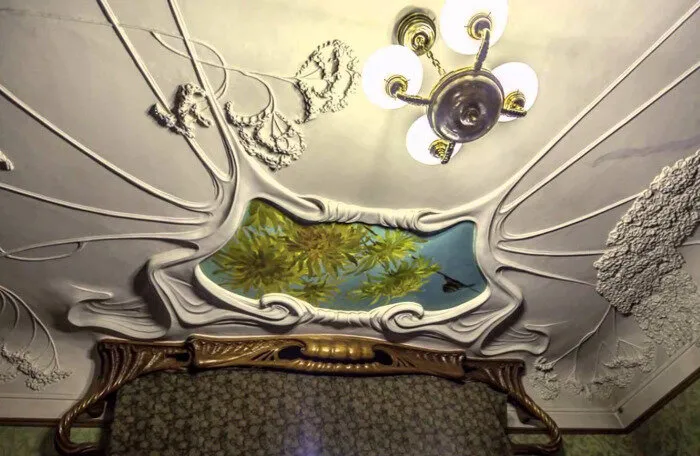
Photo: kulturologia.ru
The Famous Staircase: A Stone Wave
The centerpiece of the interior was the famous marble staircase, resembling a frozen sea wave. This is a true masterpiece of architectural art that continues to inspire admiration from visitors.
The staircase was made of white marble and flows smoothly from the first floor to the second. Its handrails imitate the crest of a wave, and the base is decorated with lanterns in the form of medusas made of frosted glass. These lanterns, designed by Schextel himself, not only served a practical function but also complemented the marine theme of the interior.
Interestingly, the staircase has no supports — it seems to float in mid-air, which was a remarkable engineering solution for its time. Schextel used a cantilever construction where each step is held in place by one end going deep into the wall.
This staircase is a true triumph of engineering thinking and artistic taste. Schextel knew how to create the illusion of weightlessness and lightness even when working with such a heavy material as marble.
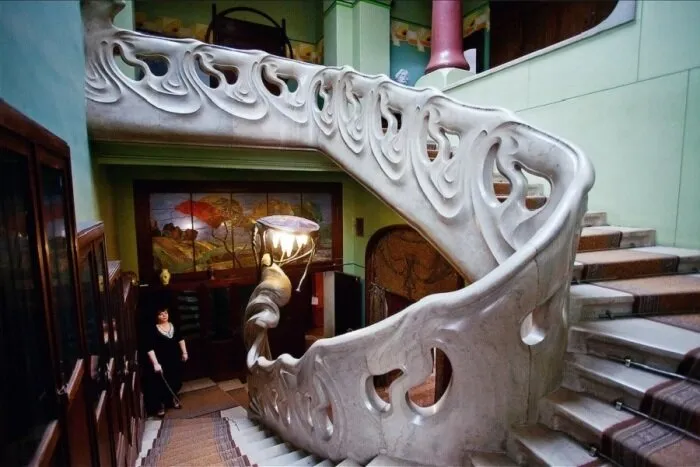
Photo: kulturologia.ru
The Secret Praying Room: Faith Under the Cover of Art
The most intriguing feature of the house is the secret Old-Believer praying room, cleverly hidden on the second floor of the manor. Until the edict on religious tolerance was issued in 1905, Old-Believers were forbidden to openly practice their faith, so praying rooms were often disguised as ordinary rooms.
In the Ryabushinsky manor, the praying room was disguised as a regular room but had several secret exits. The main entrance into it was skillfully hidden behind a cabinet in the owner's office. The cabinet could be rotated to reveal a secret passage leading to the sanctuary.
The praying room itself was decorated in the traditional style of Old-Believers. Here were kept ancient icons from the Ryabushinsky collection, some dating back to the 15th-16th centuries. Icons were hung on the walls in precious settings, and a book stand was placed in the center of the room.
Old-Believers had a special relationship with icons from the Donicon period. For them, these were not just works of art but sacred relics connecting them to the true, uncorrupted faith of their ancestors.
Interestingly, Schextel, who himself was a Catholic, treated the religious beliefs of his client with great respect and managed to seamlessly integrate the praying room into the overall concept of the house. At the same time, he created a space where modernism and ancient Russian tradition surprisingly complemented each other.
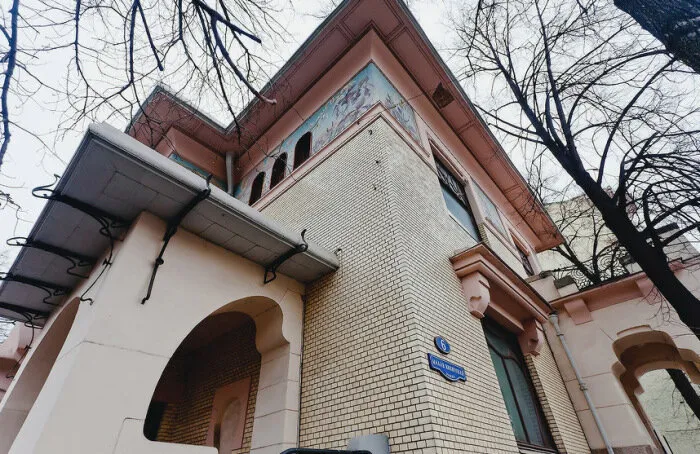
Photo: kulturologia.ru
Interiors: Each Room Is a Unique World
Besides the famous staircase and secret praying room, the Ryabushinsky manor is impressive for its variety and sophistication of interiors. Each room has its own character, color palette, and decorative motifs.
The dining room was decorated in beige-green tones with stained glass windows depicting the underwater world. The ceiling is adorned with plasterwork in the form of stylized waves and medusas, and built-in cabinets and buffet have smooth, flowing shapes.
The owner's study was done in more subdued tones with wooden panelling and built-in bookshelves. Schextel used motifs from Japanese art — stylized images of bamboo and sakura on wooden panels.
The lady's bedroom was decorated in soft pastel tones with floral motifs in the décor. Schextel designed special furniture for it with smooth, feminine lines.
The children's rooms were located in a separate wing of the house and had vivid, cheerful decoration with motifs from fairy tales and nature.
Schextel understood that a house is not just a building but an entire world where people live. Each room should correspond to the character and needs of its inhabitants.
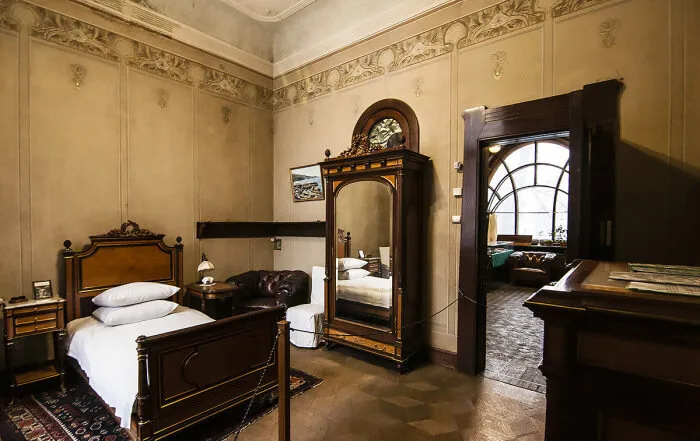
Photo: kulturologia.ru
From Ryabushinsky to Gorky: Change of Eras
After the 1917 revolution, Stepan Ryabushinsky, like many members of the Russian bourgeoisie, was forced to emigrate. The manor was nationalized and initially used as an office of the People's Commissariat of Foreign Affairs.
In 1931, after Maxim Gorky returned from Italy, the manor was transferred to him for residence by Stalin's personal order. The writer lived there until his death in 1936.
Gorky, despite his revolutionary views, held the architectural merits of the manor in great respect. He practically did not alter the interiors created by Schextel, only adding his extensive library and collection of Eastern art.
An interesting historical fact: in the Ryabushinsky manor, Gorky hosted many prominent figures of culture and politics of his time, including Romain Rolland, Bernard Shaw, and Lev Kamenev. Meetings of Soviet writers also took place here, where the concept of socialist realism was formed.
After Gorky's death, a museum apartment of the writer was established in the manor, which continues to function today. Thanks to this, many original interiors and details created by Schextel have been preserved.
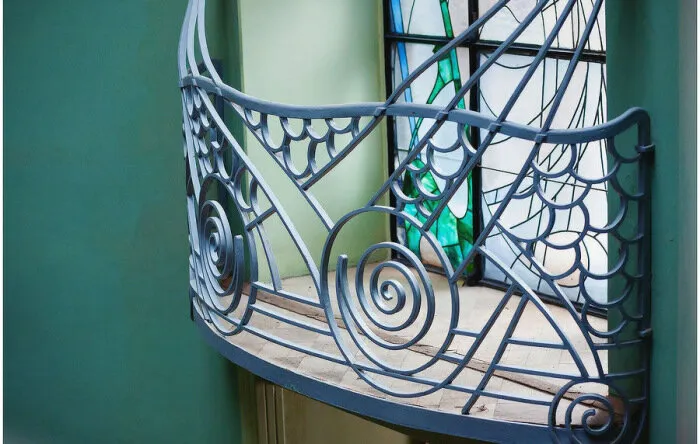
Photo: kulturologia.ru
The Manor Today: Museum and Architectural Gem
Today, the Ryabushinsky manor is a museum apartment of A.M. Gorky, a branch of the State Museum of Russian Literature named after V.I. Dahl. Visits are conducted to see unique interiors created by Schextel and learn about the history of the house and its inhabitants.
The manor remains one of the finest examples of Moscow modernism and is included in the list of federal cultural heritage objects. Architects and designers continue to draw inspiration from Schextel's work, studying his innovative solutions and attention to detail.
The phenomenon of the Ryabushinsky manor lies in its remaining relevant and modern even more than a hundred years after its construction. Many techniques used by Schextel — play with space, attention to natural lighting, organic combination of various materials — are actively used in contemporary architecture today.
Museum visitors often note the special atmosphere of the house, where history comes alive. Here, one can feel the spirit of the Silver Age of Russian culture, see how members of the Russian bourgeoisie at the beginning of the XX century lived, and appreciate the genius of the architect who created a space timeless in its essence.
Influence on Contemporary Interior Design
The Ryabushinsky manor continues to inspire modern interior designers. Many solutions first applied by Schextel can be seen in contemporary projects.
For example, the concept of 'flowing space', where rooms smoothly transition into one another without clear boundaries, became one of the main principles of modern design. Schextel was among the first to use this approach, abandoning traditional axial floor plans in favor of a more free organization of space.
Another relevant element is the use of natural motifs in décor. Stylized images of plants and marine creatures, which abound in the Ryabushinsky manor, find reflection in modern interiors in the form of biomorphic furniture and decorative elements.
Schextel was a true visionary. He created interiors that not only reflected the tastes of his clients but also formed new aesthetics and a new understanding of living spaces. Many of his ideas remain relevant today, especially the desire for ecological harmony and unity with nature.

Photo: kulturologia.ru
The House as a Reflection of the Era and Personality
The Ryabushinsky manor is not just a beautiful building or museum exhibit. It is a multi-layered work of art reflecting the era and the personalities of its creators and inhabitants. In it, modernism and ancient Russian tradition intertwine mysteriously, open displays of wealth and hidden religiosity, revolutionary ideas and bourgeois comfort.
Schextel created a manor that was the perfect reflection of Stepan Ryabushinsky's personality — a successful capitalist, art lover, and secret Old-Believer. Later, the house became witness to a new era, welcoming Maxim Gorky — 'the harbinger of the revolution' and at the same time a lover of luxury.
Today, walking through the rooms of this wonderful house, we can touch different layers of Russian history and culture, see how the country and its people changed. The Ryabushinsky manor remains one of the most vivid and mysterious architectural treasures of Moscow, continuing to attract everyone interested in history, architecture, and the human stories hidden behind them.
Cover: kulturologia.ru
More articles:
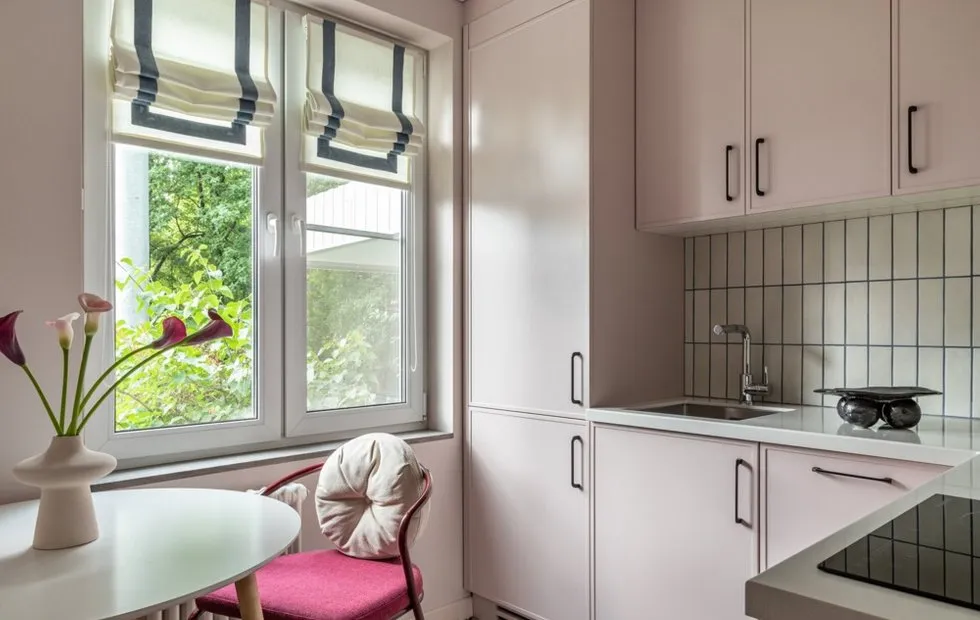 Kitchen in Panel House 6 sq.m: How to Fit Dishwasher and Oven
Kitchen in Panel House 6 sq.m: How to Fit Dishwasher and Oven Kitchen in a Khrushchyovka 6 sq. m: How to Fit a Dishwasher and Oven
Kitchen in a Khrushchyovka 6 sq. m: How to Fit a Dishwasher and Oven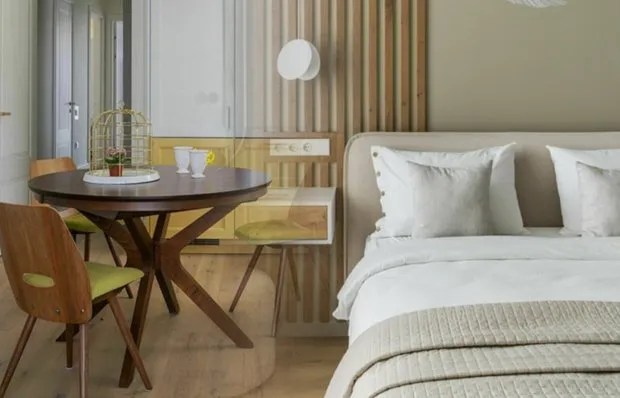 How to Do a Repair on a Limited Budget: 5 Practical Solutions
How to Do a Repair on a Limited Budget: 5 Practical Solutions How We Designed a Retro Bathroom in a Stalin-era 50 m² Apartment
How We Designed a Retro Bathroom in a Stalin-era 50 m² Apartment 5 Bright Entryways That Immediately Set the Mood
5 Bright Entryways That Immediately Set the Mood Cozy Evening Rituals for Stress Relief
Cozy Evening Rituals for Stress Relief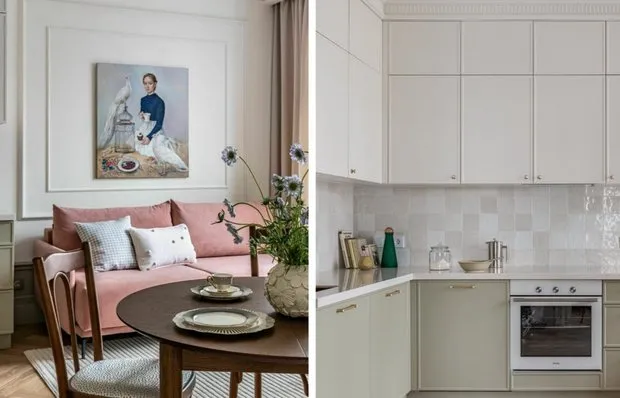 5 Design Solutions Found in a Transformed 75 m² Trash
5 Design Solutions Found in a Transformed 75 m² Trash Light Trash 65 m² Designer with Modern and Unusual Solutions
Light Trash 65 m² Designer with Modern and Unusual Solutions